ESP AUDI R8 SPYDER 2015 Repair Manual
[x] Cancel search | Manufacturer: AUDI, Model Year: 2015, Model line: R8 SPYDER, Model: AUDI R8 SPYDER 2015Pages: 232, PDF Size: 58.36 MB
Page 172 of 232

Tires and wheels
Hidden damage
Damage to tires and rims is often
not readily visible. If you notice
unusual vibration or the vehicle
pulls to one side, this may indi
cate that one of the tires has been
damaged. The tires must be
checked immediately by an au
thorized Audi dealer or qualified
workshop.
Unidirectional tires
A unidirectional tire can be identi
fied by arrows on the sidewall,
that point in the direction the tire
is designed to rotate. You must
follow the specified direction of
rotation . This is necessary so that
these tires can develop their opti
mum characteristics regarding
grip, road noise, wear and hydro
planing resistance. For more in
formation
¢ page 203 .
A WARNING ~ -
New tires or tires that are old,
worn or damaged cannot pro
vide maximum control and
braking ability.
-New tires tend to be slippery
and must be broken in. To re
duce the risk of losing control,
a collision and serious person
al injuries, drive with special
170
care for the first 350 miles (560 km).
-Driving with worn or damaged tires can lead to loss of con
trol, sudden tire failure, in
cluding a blowout and sudden
deflation, crashes and serious
personal injuries. Have worn
or damaged tires replaced im
mediately.
-Tires age even if they are not being used and can fail sud
denly, especially at high
speeds. Tires that are more
than 6 years old can only be
used in an emergency and
then with special care and at
low speed.
-Never mount used tires on your vehicle if you are not sure
of their "previous history." Old
used tires may have been
damaged even though the
damage cannot be seen that
can lead to sudden tire failure
and loss of vehicle control.
-If you notice unusual vibration
or if the vehicle pulls to one
side when driving, always stop
as soon as it is safe to do so
and check the wheels and tires
for damage.
..
Page 173 of 232

(D Note
- Please note that summer and
winter t ires are designed for
the conditions that are typical in those seasons . Audi recom
mends using winter tires dur
ing the winter months . Low
temperatures significantly de
crease the elasticity of summ
er tires, which affects traction
and braking ability. If summer
tires are used in very cold tem peratures, cracks can form on
the tread bars, resulting in
Tires and wheels
permanent tire damage that
can cause loud driving noise
and unbalanced tires . Audi is
not responsible for this type
of damage.
- Burnished, polished or
chromed rims must not be
used in winter road condi
tions . The surface of the rims
does not have sufficient corro
sion protection for this and
could be permanently dam aged by road salt or similar
substances .
Glossary of tire and loading terminology
Accessory weight
means the combined weight (in
excess of those standard items
which may be replaced) of auto
matic transmission, power steer
ing, power brakes, power win
dows , powe r seats , radio , and
heater , to the extent that these
items a re available as factory-in
stalled equipment (whether in
stalled or not).
Aspect ratio
means the ratio of the height to
;:;: the width of the tire in percent .
" ~ Numbers of 55 or lower indicate a ...
~ low sidewall for improved steer -
"' ....
ing response and better overall
handling on dry pavement.
Bead
means the part of the tire that is
made of steel wires, wrapped or
reinforced by ply cords and that is
shaped to f it the rim .
Bead separation
means a breakdown of the bond
between components in the bead .
Cord
means the strands forming the
plies in the tire.
17 1
...
Page 179 of 232
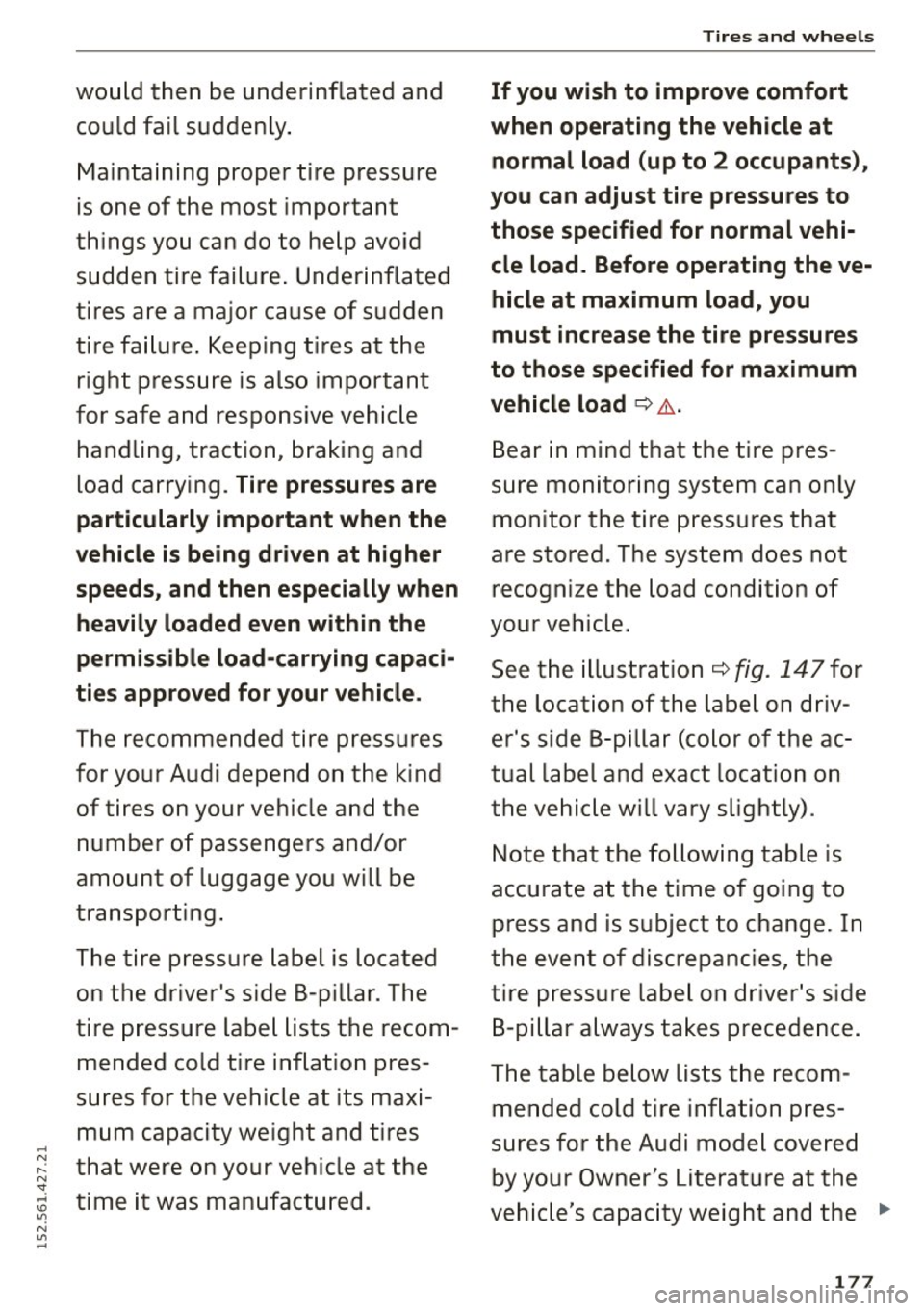
...
would then be underinflated a nd
could fail suddenly .
M ainta ining proper tire pressure
is one of the most important
things you can do to he lp avoid
s u dden tire fai lure . Under inflated
tires are a major cause of sudden
tire fa ilure . Keeping tires at the
r ight pressure is also important
for safe and responsive vehic le
handling, traction, braking and
load carrying.
Tire pressures are
particularly important when the
vehicle is be ing dr iven at higher
speeds, and then especially when
heavily loaded even within the
permissib le load-carrying capaci
ties approved for your vehicle .
The recommended tire pressures
for your Audi depend on the kind of tires on your vehicle and the
number of passengers and/or
amount of luggage you will be
transport ing .
The tire pressure label is located
on the driver's side 8-pillar . The
tire pressure label lists the recom mended cold tire inflation pres
s u res for the vehicle at its maxi
mum capacity weight and tires
~ that were on your vehicle at the
": ;;; time it was manufactured. "? N
"' ....
Tir es a nd whe els
If you wish to improve comfort
when operating the vehicle at
normal load (up to 2 occupants ),
you can adjust tire pressu res to
those specified for normal vehi
cle load . Before operating the ve
hicle at ma ximum load, you
must increa se the ti re pressures
to those specified for maximum
vehic le load
c:::> .&. .
Bear in mind that the tire pres
sure monitoring system can only monitor the tire pressures that
are stored. The system does not recognize the load condition of
your vehicle .
See the illustration
c:::> fig. 147 for
the location of the labe l on driv
er's side 8-pillar (color of the ac
tual label and exact location on
the vehicle will vary slightly).
Note that the following table is
accurate a t the time of going to
press and is subject to change . In
the event of discrepancies, the
tire pressure label on driver's side 8-pillar always takes precedence.
The table below lists the recom
mended cold tire inflation pres
sures for the Audi model covered by your Owner 's Literature at the
vehicle's capac ity weight and the .,.
177
Page 180 of 232
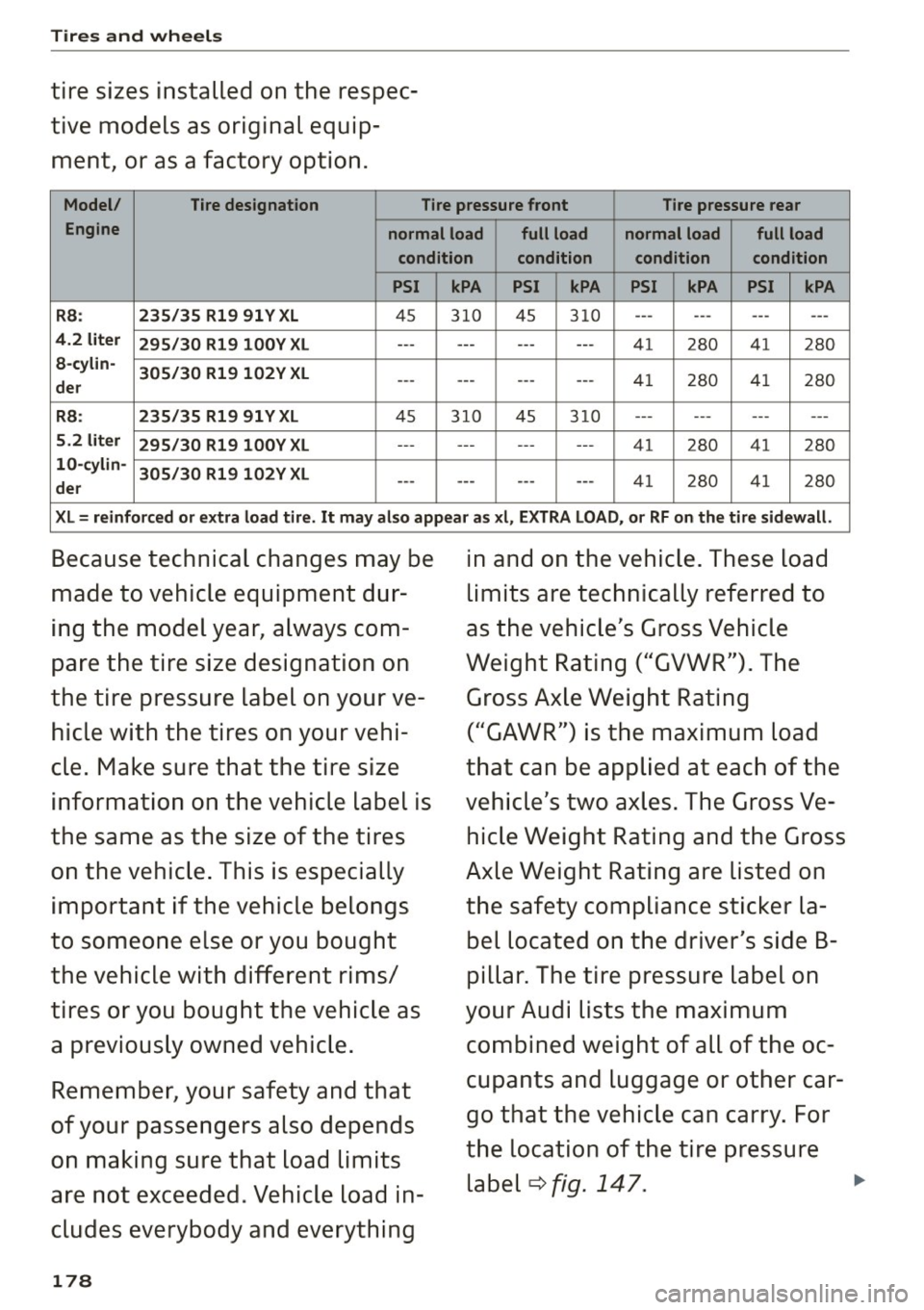
Tires and wheels
tire sizes installed on the respec
tive models as original equipment, or as a factory option.
Model/ Tire designation Tire pressure front Tire pressure rear
Engine normal load full load normal load full load
condition condition condition condition
PSI kPA PSI kPA PSI kPA PSI kPA
RS: 235/35 Rl9 91 Y XL 45 310 45 310 ------ ------
4.2 liter
295/30 Rl9 lOOY XL ------------41 280 41 280
S-cylin-
305/30 Rl9 102V XL
der
--- --- ------41
280 41 280
RS: 235/35 Rl9 91 Y XL 45 310 45 310 --------- ---
5.2 liter
295/30 Rl9 lOOY XL --------- ---41
280 41
280
10-cylin-
305/30 Rl9 102V XL
der
--- ------
---41 280 41 280
XL= reinforced or extra load tire. It may also appear as xl, EXTRA LOAD, or RF on the tire sidewall.
Because technical changes may be
made to vehicle equipment dur
ing the model year, always com
pare the tire size designation on
the tire pressure label on your ve hicle with the tires on your vehi
cle. Make sure that the tire size information on the vehicle label is
the same as the size of the tires on the vehicle. This is especially
important if the vehicle belongs
to someone else or you bought
the vehicle with different rims/
tires or you bought the vehicle as a previously owned vehicle.
Remember, your safety and that
of your passengers also depends
on making sure that load limits
are not exceeded. Vehicle load in
cludes everybody and everything
178
in and on the vehicle. These load
limits are technically referred to
as the vehicle's Gross Vehicle
Weight Rating ("GVWR"). The
Gross Axle Weight Rating ("GAWR") is the maximum load
that can be applied at each of the
vehicle's two axles. The Gross Ve hicle Weight Rating and the Gross
Axle Weight Rating are listed on
the safety compliance sticker la bel located on the driver's side B
pillar. The tire pressure label on
your Audi lists the maximum combined weight of all of the oc
cupants and luggage or other car
go that the vehicle can carry. For
the location of the tire pressure label ¢
fig. 147.
Page 183 of 232

.... N
" N ": ... IO "? N U'> .....
-Place the air pressure gauge on the valve .
- The tire pressu res should only be
checked an d adjusted when the
t ires are cold. The slig htly raised
pressures of warm tires must
not be reduced .
- Adjust the tire pressure to the
load you are carrying.
-Reinstall the valve stem cap on the valve .
When should I check the tire
pressu re?
The correct tire pressure is espe
cially important at high speeds .
The pressure should therefore be
checked at least once a month
and always before starting a jour
ney.
When should I adjust the tire pressures ?
Adjust the tire pressure to the
load you are carrying . After
changing a wheel
or replacing
wheels you have to adjust the tire pressures on all wheels. In addi
tion, you must then initialize the
new tire pressures in the tire pres
sure mon itoring system
¢page 196 .
Tires and wheels
A WARNING
Incorrect tire pressures and/or
underinflation can lead sudden
tire failure, loss of control, col lision, serio us personal injury or
even death .
-When the warning symbol
rD]
appears in the instrument
cluster, stop and inspect the
tires.
- Incorrect tire pressure and/or
underinflation can cause in
creased tire wear and can af
fect the handling of the vehi
cle and stopping ab ility.
- Incorrect tire pressures and/or
underinflation can also lead to
sudden tire failure, including a
blowout and sudden deflation,
causing loss of vehicle control.
- The driver is responsib le for
the correct tire pressures for
all t ires on the vehicle . The ap
plicable pressure values are lo
cated on a sticker on the driv
er's side B-pillar.
-Only when all tires on the ve hicle are filled to the correct
pressure, the tire pressure monitoring system can work
correct ly .
1 8 1
..
Page 188 of 232
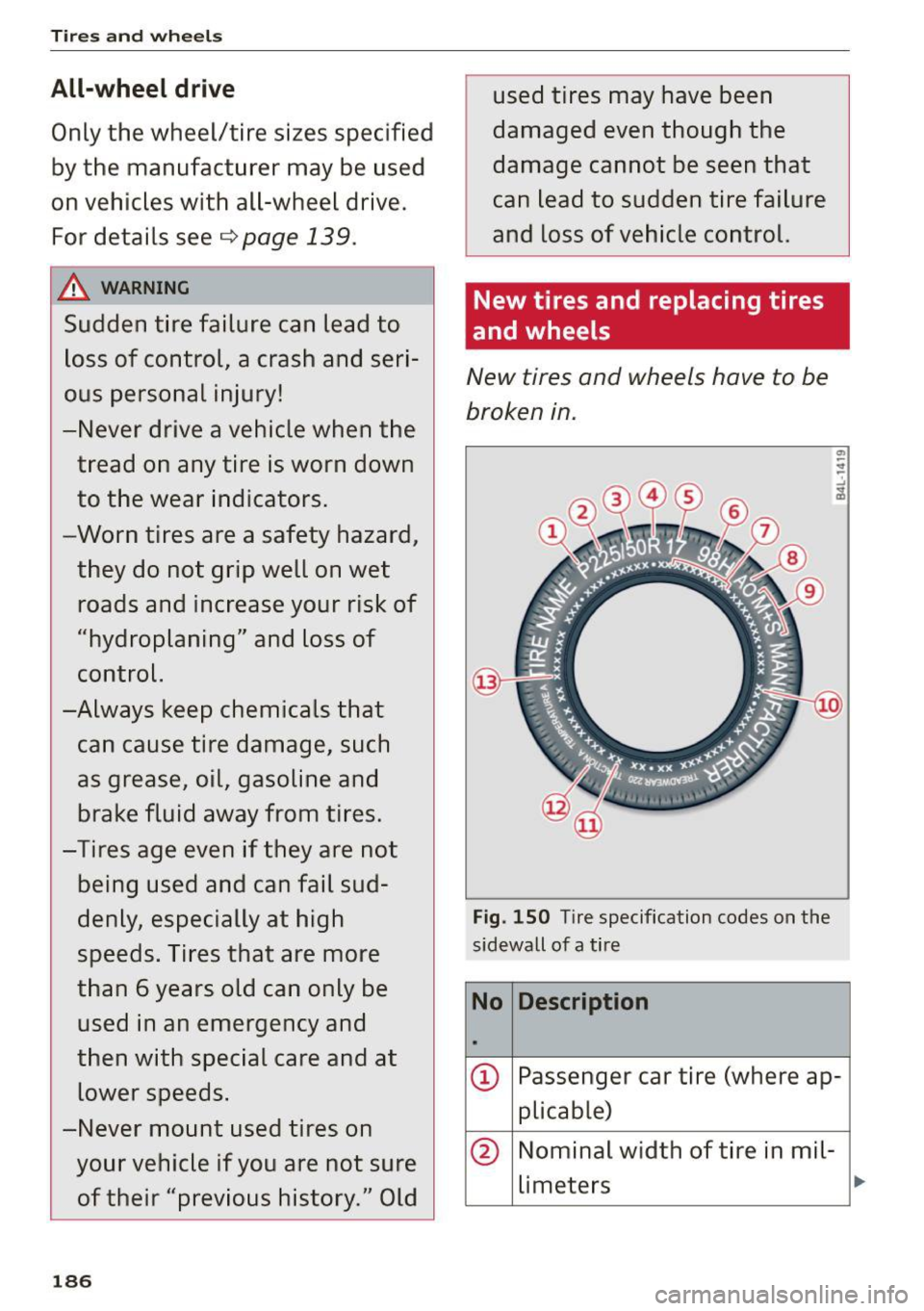
Tires and wheels
All-wheel drive
Only the wheel/tire sizes specified
by the manufacturer may be used
on vehicles with all-wheel drive. For details see¢
page 139.
A WARNING
Sudden tire failure can lead to
loss of control, a crash and seri
ous personal injury!
-Never drive a vehicle when the tread on any tire is worn down
to the wear indicators.
-Worn tires are a safety hazard,
they do not grip well on wet
roads and increase your risk of
"hydroplaning" and loss of
control.
-Always keep chemicals that can cause tire damage, such
as grease, oil, gasoline and brake fluid away from tires.
-Tires age even if they are not
being used and can fail sud
denly, especially at high
speeds. Tires that are more
than 6 years old can only be
used in an emergency and
then with special care and at lower speeds.
-Never mount used tires on
your vehicle if you are not sure
of their "previous history." Old
186
used tires may have been
damaged even though the
damage cannot be seen that
can lead to sudden tire failure
and loss of vehicle control.
New tires and replacing tires
. and wheels
New tires and wheels have to be
broken in.
Fig. 150 Tire specification codes on the
sidewall of a tire
No Description
•
@ Passenger car tire (where ap-
plicable)
@ Nominal width of tire in mil-
limeters
Page 193 of 232
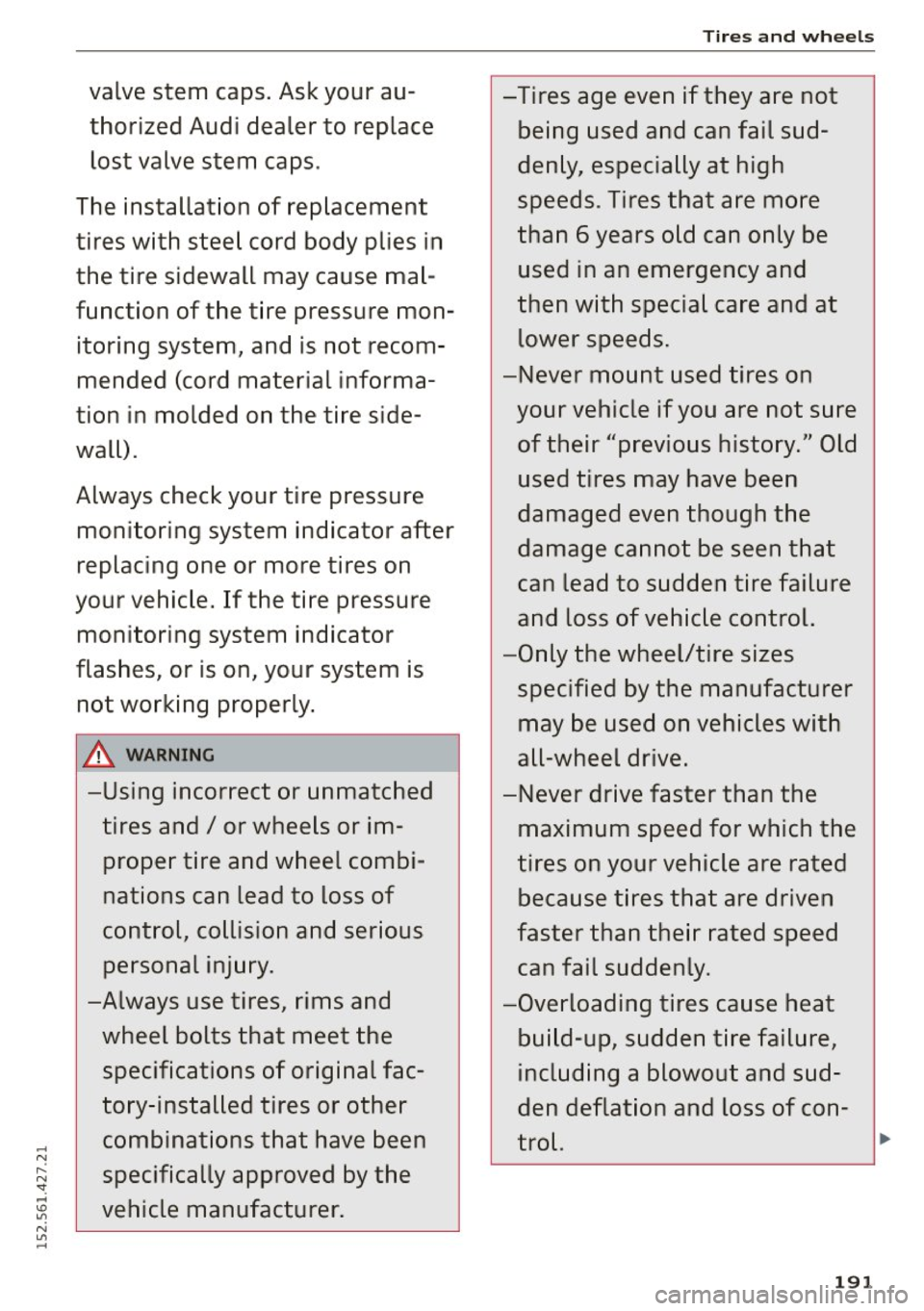
Tires and wheels
valve stem caps. Ask your au--Tires age even if they are not
thorized Audi dealer to replace being used and can fail sud-
lost valve stem caps .
denly, especially at high
The installation of replacement speeds
. Tires that are more
tires with steel cord body plies in than 6 years old can only be
the tire sidewall may cause mal- used
in an emergency and
function of the tire pressure man- then with special care and at
itoring system, and is not recom- lower speeds.
mended (cord material informa- -Never mount used tires on
tion in molded on the tire side- your vehicle if you are not sure
wall). of their "previous history." Old
Always check your tire pressure used tires may have been
damaged even though the
monitoring system indicator after
damage cannot be seen that
replacing one or more tires on
can lead to sudden tire failure
your vehicle. If the tire pressure
and loss of vehicle control.
monitoring system indicator
-Only the wheel/tire sizes
flashes, or is on, your system is
specified by the manufacturer
not working properly.
may be used on vehicles with
A_ WARNING all-wheel drive.
-Using incorrect or unmatched -Never drive faster than the
tires and/ or wheels or im- maximum speed for which the
proper tire and wheel com bi -
tires on your vehicle are rated
nations can lead to loss of because tires that are driven
control, collision and serious faster than their rated speed
personal injury. can fail suddenly.
-Always use tires, rims and
-Overloading tires cause heat
wheel bolts that meet the build-up, sudden tire failure,
specifications of original fac- including a blowout and sud-
tory-installed tires or other den deflation and loss of con-
combinations that have been trol.
... .... N
" specifically approved by the N ": ...
vehicle manufacturer. IO "? N
"' ....
191
Page 195 of 232
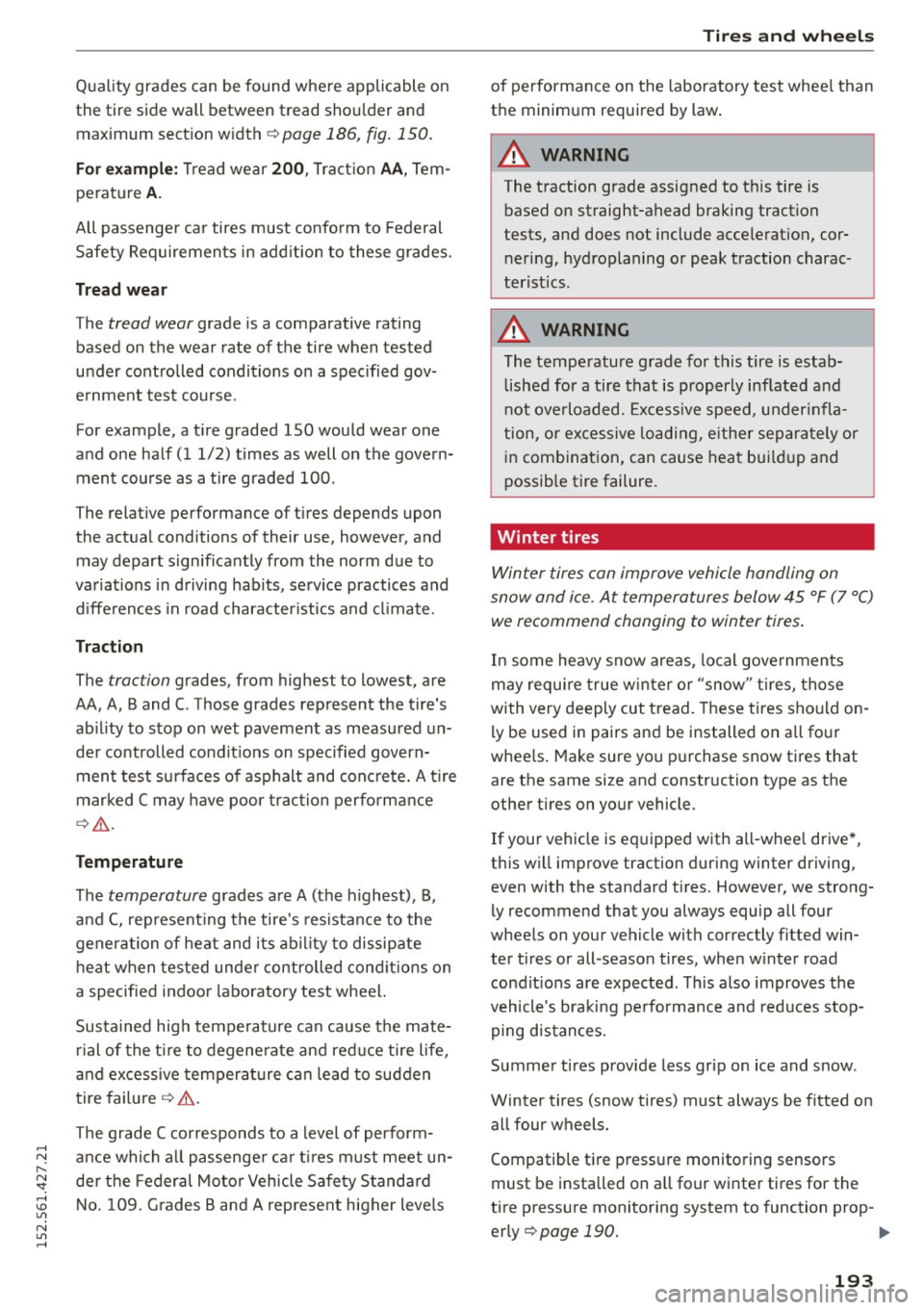
..... N
r-N "': ..... \!) 1.1'1
N 1.1'1 .....
Quality grades can be found where applicable on
the tire side wall between tread shoulder and maximum sect ion w idth
r::!:> page 186, fig. 150.
For example: Tread wear 200, Traction AA , Tem
perature
A.
All passenger car tires must conform to Federal
Safety Requirements in addition to these grades.
Tread wear
The tread wear grade is a comparative rating
based on the wear rate of the tire when tested
under controlled conditions on a spec ified gov
e rnment test course.
For example, a t ire graded
150 would wear one
and one half (1 1/2) times as well on the govern
ment course as a tire graded
100 .
The relative performance of tires depends upon
the actual conditions of their use, however, and
may depart significantly from the norm due to
variations in driving hab its, serv ice practices and
differences in road characteristics and climate.
Traction
The traction grades, from highest to lowest, are
AA, A, B and
C. Those grades represent the tire's
ab il ity to stop on wet pavement as measured un
der controlled condit ions on specified govern
ment test surfaces of asphalt and concrete. A tire
marked C may have poor traction performance
r::!;> .&. .
Temperature
The temperature grades are A (the highest), B,
and C, representing the tire's resistance to the
generation of heat and its ability to dissipate
h eat when tested under controlled cond it ions on
a specified indoor laboratory test wheel.
Sustained high temperature can cause the mate
rial of the tire to degene rate and reduce tire life,
and excessive temperature can lead to sudden
tire failure
r::!:> .&. .
The grade C corresponds to a level of perform
ance which all passenger car tires must meet un
der the Federal Motor Vehicle Safety S tanda rd
No.
109. Grades Band A represent higher levels
Tires and wheels
of performance on the laboratory test whee l than
the minimum required by law .
A WARNING
-
-
The traction grade assigned to th is tire is
based on straight-ahead braking traction
tests, and does not include accelerat ion, cor
nering, hydroplaning or peak traction charac
terist ics.
A WARNING
= -
The temperature grade for this tire is estab-
lished for a tire that is properly inflated and
not overloaded. Excessive speed, underinfla
tion, or excessive loading, either separately or
in combination, can cause heat buildup and
possible tire failure.
Winter tires
Winter tires can improve vehicle handling on
snow and ice . At temperatures below 45 °F (7 °C)
we recommend changing to winter tires .
In some heavy snow areas, local gove rnments
may require true wint er or "snow" tires, those
with very deeply cut tread. These tires should on
ly be used in pairs and be installed on a ll four
wheels. Make sure you purchase snow tires that
are the same size and construction type as the other tires on your vehicle.
If your vehicle is equipped with all-whee l drive *,
this will improve traction during winter driving,
even with the standard tires. However, we strong
ly recommend that you always equip all four
wheels on your vehicle with correctly fitted win
ter tires or all-season tires, when w inter road
condit ions are expected. This also improves the
vehicle's braking pe rformance and reduces stop
ping distances.
Summer tires provide less grip on ice and snow .
Winter tires (snow tires) must always be fitted on
all four wheels.
Compatible t ire pressure monitoring sensors
must be installed on all four winter tires for the
tire pressure monitoring system to function prop- erly
¢ page 190. ..,.
193
Page 198 of 232
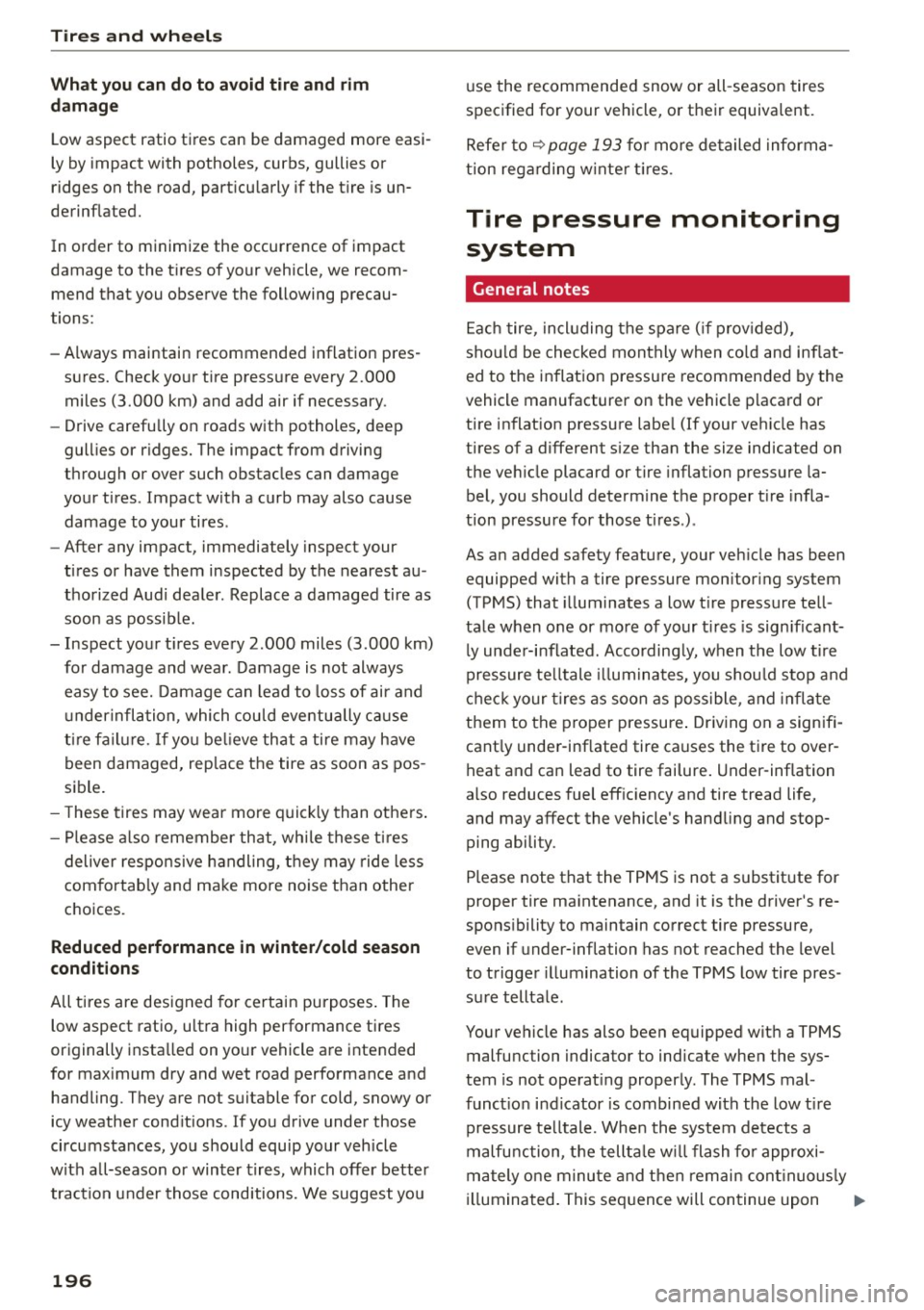
Tires and wheel s
What you can do to avoid tire and rim
damag e
Low aspect ratio tires can be damaged more easi
ly by impact with potholes, curbs, gullies or
ridges on the road, part icularly if the t ire is un
derinflated.
In order to minimize the occurrence of impact
damage to the tires of your vehicle, we recom mend that you observe the following precau
tions:
- Always maintain recommended inflation pres
su res. Check your tire pressure every 2.000
miles (3.000 km) and add air if necessary .
- Drive carefu lly on roads w ith potholes, deep
gull ies or r idges. The impact from driving
through or over such obstacles can damage
your tires . Impact with a curb may also cause
damage to you r tires .
- After any impact, immediately inspec t your
tires or have them inspected by the nearest au
thorized Audi dealer. Replace a damaged tire as soon as possib le.
- Inspect you r tires every 2 .000 miles (3 .000 km)
for damage and wear. Damage is not always easy to see. Damage can lead to loss of ai r and
u nderinflation , which cou ld eventua lly cause
t ir e fa ilure. If yo u be lieve that a tire may have
been damaged, rep lace the tire as soon as pos
sible .
- T hese tires may wear more q uick ly than others .
- Please a lso remembe r that, wh ile these ti res
deliver responsive handling, t hey may ride less
com fortab ly and make more noise than other
choices.
R educed performance in winter /cold season
condit ions
All ti res are designed for certain pu rposes . The
low aspect ratio, u ltra high performance tires
originally insta lled on your vehicle are intended
for maximum dry and wet road performance and handling. They are not suitable for cold, snowy or
icy weather cond itions . If you drive under those
circumstances, you should equip your vehicle
with all-season or winter tires, which offer better traction under those conditions. We suggest you
196
u se the recommended snow or all-season tires
specified for your vehicle, or their equivalent.
Refer to~
page 193 for more de tailed informa
tion regarding w inter t ires.
Tire pressure monitoring
system
General notes
E ach tire, incl uding the spare ( if prov ided),
shou ld be checked monthly when co ld and inflat
ed to the inflation pressure recommended by the
vehicle manufacturer on the vehicle placa rd or
tire inflation pressure labe l (If your vehicle has
tires of a different s iz e than the si ze indicated on
the ve hicle placard or tire inflation pressure la
bel, you should determine the proper t ire infla
tion pressure for those tires .) .
As an added safety feature, your veh icle has been
equipped with a tire pressure mon itor ing system
(TPMS) that illuminates a low t ire pressure tell
ta le when one or more of your t ires is sign ificant
l y unde r-inflated. According ly, when the low tire
pressure te lltale illuminates, you shou ld stop and
chec k yo ur ti res as soon as poss ible, and infla te
them to the proper pressure . Dr iv ing on a signifi
cant ly under-inflated tire ca uses the t ire to over
heat and ca n lead to tire failure . Under-inflation
also reduces fuel effic iency and tire tread life,
and may affect the vehicle 's handling and stop
ping abili ty .
Please note that the TPMS is not a substitute for
proper tire maintenance, and it is the driver's re
spons ibility to maintain correct tire pressure,
even if under-infla tion has not reached the level
to trigger illumination of the TPMS low tire pres
sure telltale.
Your vehicle has also been equipped with a TPMS malfunc tion indicator to indicate when the sys
tem is not operat ing properly . The TPMS mal
funct ion indicator is combined with the low t ire
pressure te lltale. When the system detects a
malfu nction, the tellta le w ill flash for approxi
mately one m inute and then remain cont inuo usly
i ll uminated. This seq uence will continue upon .,.
Page 199 of 232
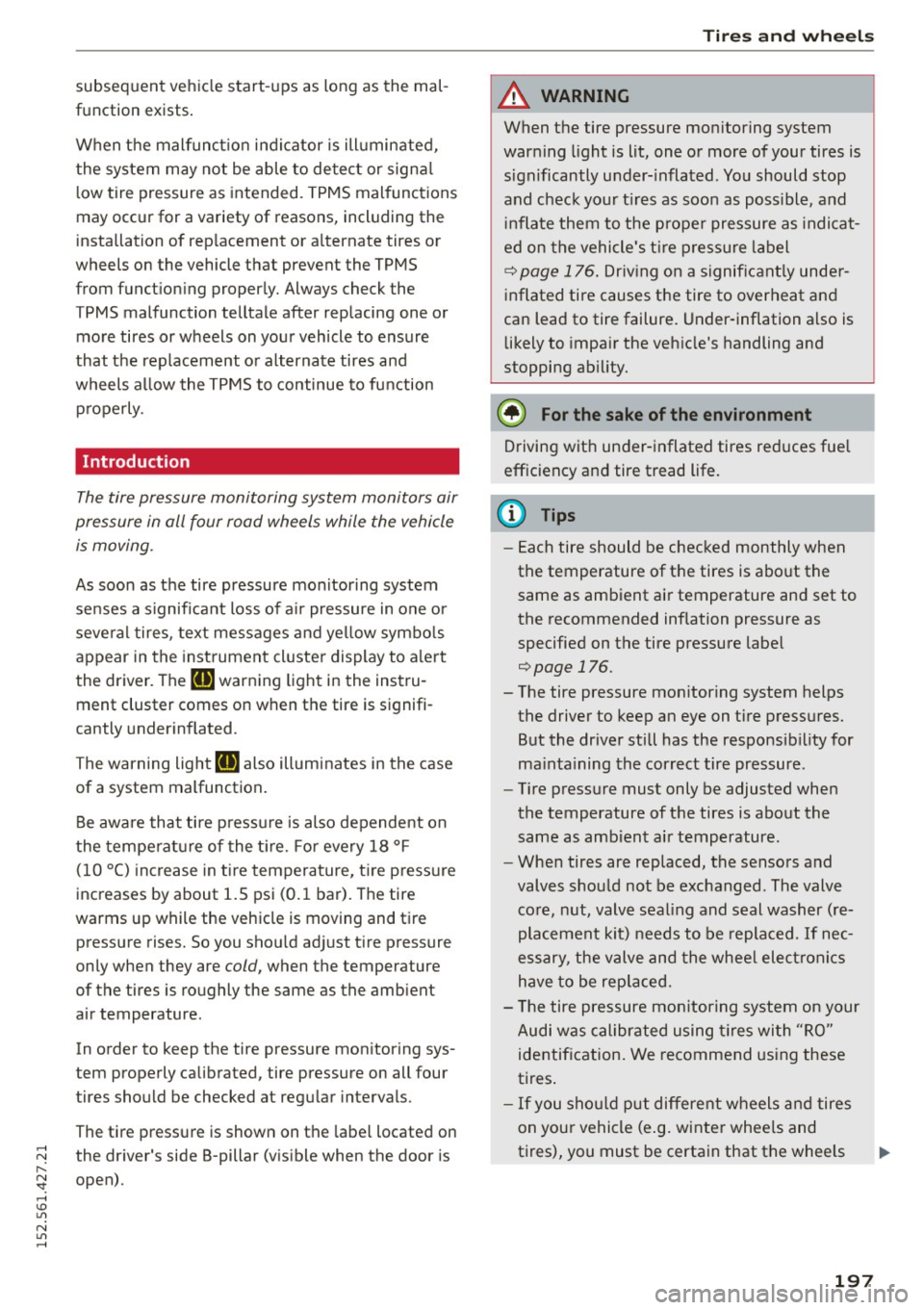
subsequent vehicle start-ups as long as the mal
function exists.
When the malfunction indicator is illuminated,
the system may not be able to detect or signa l
l ow tire pressure as intended. TPMS malfunctions
may occur for a variety of reasons, including the
installation of rep lacement or a lternate tires or
wheels on the vehicle that prevent the TPMS from functioning properly. Always check the
T PMS malfunction telltale after replacing one or
more tires or wheels on your vehicle to ensure
that the replacement or alternate tires and
wheels allow the TPMS to continue to function
properly .
Introduction
The tire pressure monitoring system monitors air
pressure in all four road wheels while the vehicle
is moving.
As soon as the tire pressure monitoring system
senses a s ignificant loss of a ir pressure in one or
several tires, text messages and ye llow symbo ls
appear in the instrument cluster display to a le rt
the driver. The
[I] warning light in the instru
ment cluster comes on when the tire is signifi
cantly underinflated .
The warning
light [l'J also illuminates in the case
of a system malfunction.
Be aware that tire p ressure is also dependent on
the temperat ure of the t ire. For every 18 ° F
(10 °() increase in tire temperature, tire pressure
increases by about 1.5 psi (0.1 bar) . The tire
warms up while the vehicle is moving and tire
pressure rises. So you shou ld adjust tire pressure
only when they are
cold, when the temperature
of the tires is roughly the same as the ambient
air temperature.
In order to keep the tire pressure monitoring sys
tem properly calibrated, tire pressure on all four
tires should be checked at regular intervals .
The tire pressure is shown on the label located on
~ the driver 's side B-pillar (visible when the door is r--
~ open) .
,...., \!) ..,.,
N
"' ,....,
Tires a nd w hee ls
A WARNING
-
When the tire pressure monitoring system
warning light is lit, one or more of your tires is
significantly under- inflated . You should stop
and check your t ires as soon as poss ible, and
i nflate them to the proper pressure as indicat
ed on the vehicle 's t ire pressure label
¢ page 176. Driving on a significant ly under
inflated tire causes the tire to overheat and
can lead to tire failure. Under-inflation also is
likely to impair the vehicle's handling and
stopping ability.
@ For the sake of the environment
Driving with under -inflated tires reduces fuel
efficiency and tire tread life.
(D Tips
- Each tire should be checked monthly when
the temperature of the tires is about the
same as ambient air temperature and set to
the recommended inflation pressure as
specified on the tire pressure label
¢page 176.
- The tire pressure mon itoring system helps
the driver to keep an eye on tire pressures.
But the driver still has the responsib ility for
ma inta ining the correct tire pressure.
- Tire pressure must only be adjusted when
the temperature of the tires is about the
same as amb ient air temperature.
- When tires are replaced, the sensors and
valves should not be exchanged. The valve
core, nut, valve seal ing and seal washer (re
placement kit) needs to be replaced. If nec
essary, the valve and the wheel electronics
have to be replaced.
- The tire pressure mon itoring system on your
Audi was calibrated using tires with "RO"
identification. We recommend using these
tires .
- If you sho uld put different wheels and tires
on your vehicle (e .g. winter whee ls and
tires), you must be certain that the wheels
197